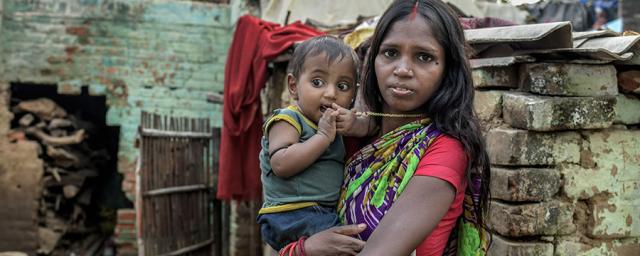
Chhatiya is a young mother who lives in an urban slum in Patna in northeast India. With her husband they were forced into debt to pay private healthcare fees for their new-born son when the public clinic was unable to provide the care he needed.
“What is particularly worrying in India’s case is that economic inequality is being added to a society that is already fractured along the lines of caste, religion, region and gender.”
While India is one of the fastest growing economies in the world, it is also one of the most unequal countries.
Inequality has been rising sharply for the last three decades. The richest have cornered a huge part of the wealth created through crony capitalism and inheritance.
They are getting richer at a much faster pace while the poor are still struggling to earn a minimum wage and access quality education and healthcare services, which continue to suffer from chronic under-investment.
These widening gaps and rising inequalities affect women and children the most.
Let's look at the numbers
| 1% |
The top 10% of the Indian population holds 77% of the total national wealth. 73% of the wealth generated in 2017 went to the richest 1%, while *670 million Indians who comprise the poorest half of the population saw only a 1% increase in their wealth. |
| 70 |
There are 119 billionaires in India. Their number has increased from only 9 in 2000 to 101 in 2017. Between 2018 and 2022, India is estimated to produce 70 new millionaires every day. |
| 10x |
Billionaires' fortunes increased by almost 10 times over a decade and their total wealth is higher than the entire Union budget of India for the fiscal year 2018-19, which was at INR 24422 billion. |
| 63 M |
Many ordinary Indians are not able to access the health care they need. 63 million of them are pushed into poverty because of healthcare costs every year - almost two people every second. |
| 941 yrs |
It would take 941 years for a minimum wage worker in rural India to earn what the top paid executive at a leading Indian garment company earns in a year. |
A ward in the department of obstetrics at Gardanibag Hospital in Patna, Bihar state. In the deprived, densely populated state of Bihar, eastern India, the public health system is failing the poorest people living in city slums. There aren’t enough health centers to serve everyone, and the facilities that exist are ill-equipped and under-staffed. The poorest people have no other option – they cannot afford the private health services available in the area.
Healthcare as a luxury good
While the Indian government barely taxes its wealthiest citizens, its spending on public healthcare ranks among the lowest in the world. In the place of a well-funded health service, it has promoted an increasingly powerful commercial health sector.
As a result, decent healthcare is a luxury only available to those who have the money to pay for it. While the country is a top destination for medical tourism, the poorest Indian states have infant mortality rates higher than those in sub-Saharan Africa. India accounts for 17% of global maternal deaths, and 21% of deaths among children below five years.
Pratima, a casualty of India's growing inequality
Pratima, 32, lives with her husband and 14-year-old daughter in the city of Patna, in Bihar state in eastern India. The family belongs to a marginalized group and lives in one of Patna’s urban slums. Pratima lost her twin babies through delays and poor treatment after she gave birth at her local government clinic.
When she became pregnant, Pratima wasn’t able to get the maternal health services she needed, or the correct advice to prepare for a safe pregnancy and childbirth. Though there is a public primary health center barely 500 meters from her house, it is not equipped to provide antenatal care.
In the eighth month of her pregnancy, she experienced severe contractions and went to the primary health center. She was compelled to wait for hours before an operation was performed. Her baby girl was already dead but her newborn son was still alive. As he was very weak, Pratima and her husband had to find an incubator in a private clinic and ran up a huge debt in order to pay for treatment. When the money ran out, their son was sent back to the government clinic - where he died a few days later.
Get involved and fight inequality today
Inequality affects us all. Oxfam is calling on governments to invest more in making quality essential services available to everyone – and to help fund this by taxing wealth more fairly.
Support Oxfam India’s campaign to urge the Indian government to provide such services and end under taxation of corporates and rich individuals.

